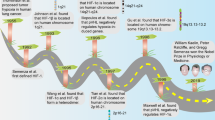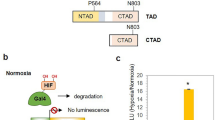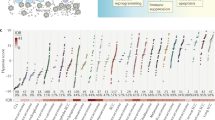Abstract
We are developing new gene therapy vectors whose expression is selectively activated by hypoxia, a unique feature of human solid tumors. As vascular endothelial growth factor (VEGF) is upregulated by hypoxia, such regulatory mechanisms would enable us to achieve hypoxia-inducible expression of therapeutic genes. Constructs with five copies of hypoxia-responsive elements (HREs) derived from the 5′-untranslated region (UTR) of the human VEGF showed excellent transcriptional activation at low oxygen tension relevant to tumor hypoxia. In an attempt to achieve higher responsiveness, various combinations of HREs and promoters were examined. In addition, we also investigated whether the 3′ UTR of the VEGF gene would confer increased post-transcriptional mRNA stability under hypoxic conditions. However, despite increases in the hypoxic/aerobic ratio of luciferase activity, gene expression with 3′ UTR was lower due to mRNA destabilization by AU-rich elements (AREs). Thus, we found no benefit from the inclusion of the 3′ UTR in our vectors. Of all the vectors tested, the combination of 5HRE and a CMV minimal promoter exhibited hypoxia responsiveness (over 500-fold) to the similar level to the intact CMV promoter. We propose that this vector would be useful for tumor selective gene therapy.
This is a preview of subscription content, access via your institution
Access options
Subscribe to this journal
Receive 12 print issues and online access
$259.00 per year
only $21.58 per issue
Buy this article
- Purchase on Springer Link
- Instant access to full article PDF
Prices may be subject to local taxes which are calculated during checkout




Similar content being viewed by others
References
Martiniello WR et al. In vivo gene therapy for prostate cancer: preclinical evaluation of two different enzyme-directed prodrug therapy systems delivered by identical adenovirus vectors Hum Gene Ther 1998 9: 1617–1626
Lan KH et al. In vivo selective gene expression and therapy mediated by adenoviral vectors for human carcinoembryonic antigen-producing gastric carcinoma Cancer Res 1997 57: 4279–4284
Harris JD et al. Gene therapy for cancer using tumour-specific prodrug activation Gene Therapy 1994 1: 170–175
Fox ME et al. Anaerobic bacteria as a delivery system for cancer gene therapy: in vitro activation of 5-fluorocytosine by genetically engineered clostridia (published erratum appears in Gene Therapy 1996; 3: 741) Gene Therapy 1996 3: 173–178
Lemmon MJ et al. Anaerobic bacteria as a gene delivery system that is controlled by the tumor microenvironment Gene Therapy 1997 4: 791–796
Dachs GU et al. Targeting gene expression to hypoxic tumor cells Nature Med 1997 3: 515–520
Shibata T et al. Enhancement of gene expression under hypoxic conditions using fragments of the human vascular endothelial growth factor and the erythropoietin genes Int J Radiat Oncol Biol Phys 1998 42: 913–916
Brown JM, Giaccia AJ . The unique physiology of solid tumors: opportunities (and problems) for cancer therapy Cancer Res 1998 58: 1408–1416
Brizel DM et al. Tumor hypoxia adversely affects the prognosis of carcinoma of the head and neck Int J Radiat Oncol Biol Phys 1997 38: 285–289
Hockel M et al. Intratumoral pO2 predicts survival in advanced cancer of the uterine cervix Radiother Oncol 1993 26: 45–50
Nordsmark M, Overgaard M, Overgaard J . Pretreatment oxygenation predicts radiation response in advanced squamous cell carcinoma of the head and neck Radiother Oncol 1996 41: 31–39
Goldberg MA et al. The regulated expression of erythropoietin by two human hepatoma cell lines Proc Natl Acad Sci USA 1987 84: 7972–7976
Semenza GL, Wang GL . A nuclear factor induced by hypoxia via de novo protein synthesis binds to the human erythropoietin gene enhancer at a site required for transcriptional activation Mol Cell Biol 1992 12: 5447–5454
Shweiki D et al. Vascular endothelial growth factor induced by hypoxia may mediate hypoxia-initiated angiogenesis Nature 1992 359: 843–845
Semenza GL et al. Hypoxia-inducible nuclear factors bind to an enhancer element located 3′ to the human erythropoietin gene Proc Natl Acad Sci USA 1991 88: 5680–5684
Madan A, Curtin PT . A 24-base-pair sequence 3′ to the human erythropoietin gene contains a hypoxia-responsive transcriptional enhancer Proc Natl Acad Sci USA 1993 90: 3928–3932
Semenza GL et al. Transcriptional regulation of genes encoding glycolytic enzymes by hypoxia-inducible factor 1 J Biol Chem 1994 269: 23757–23763
Semenza GL et al. Hypoxia response elements in the aldolase A, enolase 1, and lactate dehydrogenase A gene promoters contain essential binding sites for hypoxia-inducible factor 1 J Biol Chem 1996 271: 32529–32537
Goldberg MA, Schneider TJ . Similarities between the oxygen-sensing mechanisms regulating the expression of vascular endothelial growth factor and erythropoietin J Biol Chem 1994 269: 4355–4359
Shima DT, Deutsch U, D'Amore PA . Hypoxic induction of vascular endothelial growth factor (VEGF) in human epithelial cells is mediated by increases in mRNA stability FEBS Lett 1995 370: 203–208
Forsythe JA et al. Activation of vascular endothelial growth factor gene transcription by hypoxia-inducible factor 1 Mol Cell Biol 1996 16: 4604–4613
Levy AP, Levy NS, Goldberg MA . Post-transcriptional regulation of vascular endothelial growth factor by hypoxia J Biol Chem 1996 271: 2746–2753
Caput D et al. Identification of a common nucleotide sequence in the 3′-untranslated region of mRNA molecules specifying inflammatory mediators Proc Natl Acad Sci USA 1986 83: 1670–1674
Wilson T, Treisman R . Removal of poly(A) and consequent degradation of c-fos mRNA facilitated by 3′ AU-rich sequences Nature 1988 336: 396–399
Shaw G, Kamen R . A conserved AU sequence from the 3′ untranslated region of GM-CSF mRNA mediates selective mRNA degradation Cell 1986 46: 659–667
Levy NS, Goldberg MA, Levy AP . Sequencing of the human vascular endothelial growth factor (VEGF) 3′ untranslated region (UTR): conservation of five hypoxia-inducible RNA-protein binding sites Biochim Biophys Acta 1997 1352: 167–173
Damert A et al. Up-regulation of vascular endothelial growth factor expression in a rat glioma is conferred by two distinct hypoxia-driven mechanisms Cancer Res 1997 57: 3860–3864
Jiang BH et al. Hypoxia-inducible factor 1 levels vary exponentially over a physiologically relevant range of O2 tension Am J Physiol 1996 27: C1172–C1180
Dachs GU, Stratford IJ . The molecular response of mammalian cells to hypoxia and the potential for exploitation in cancer therapy Br J Cancer 1996 74: S126–S132
Adam MF et al. Tissue oxygen distribution in head and neck cancer patients Head Neck 1999 21: 146–153
Claffey KP et al. Identification of a human VPF/VEGF 3′ untranslated region mediating hypoxia-induced mRNA stability Mol Biol Cell 1998 9: 469–481
Shyu AB, Greenberg ME, Belasco JG . The c-fos transcript is targeted for rapid decay by two distinct mRNA degradation pathways Genes Dev 1989 3: 60–72
Gossen M, Bujard H . Tight control of gene expression in mammalian cells by tetracycline-responsive promoters Proc Natl Acad Sci USA 1992 89: 5547–5551
Gossen M et al. Transcriptional activation by tetracyclines in mammalian cells Science 1995 268: 1766–1769
Brown JM . SR 4233 (tirapazamine): a new anticancer drug exploiting hypoxia in solid tumours Br J Cancer 1993 67: 1163–1170
Mazure NM et al. Oncogenic transformation and hypoxia synergistically act to modulate vascular endothelial growth factor expression Cancer Res 1996 56: 3436–3440
Liu Y et al. Hypoxia regulates vascular endothelial growth factor gene expression in endothelial cells. Identification of a 5′ enhancer Circ Res 1995 77: 638–643
Boshart M et al. A very strong enhancer is located upstream of an immediate–early gene of human cytomegalovirus Cell 1985 41: 521–530
Acknowledgements
This work was supported by PO1 CA-67166.
Author information
Authors and Affiliations
Rights and permissions
About this article
Cite this article
Shibata, T., Giaccia, A. & Brown, J. Development of a hypoxia-responsive vector for tumor-specific gene therapy. Gene Ther 7, 493–498 (2000). https://doi.org/10.1038/sj.gt.3301124
Received:
Accepted:
Published:
Issue Date:
DOI: https://doi.org/10.1038/sj.gt.3301124
Keywords
This article is cited by
-
High throughput screen for the improvement of inducible promoters for tumor microenvironment cues
Scientific Reports (2022)
-
4-O-Methylascochlorin inhibits the prolyl hydroxylation of hypoxia-inducible factor-1α, which is attenuated by ascorbate
The Journal of Antibiotics (2019)
-
Molecular and functional imaging insights into the role of hypoxia in cancer aggression
Cancer and Metastasis Reviews (2019)
-
The hypoxic tumor microenvironment in vivo selects the cancer stem cell fate of breast cancer cells
Breast Cancer Research (2018)
-
Gene delivery of hypoxia-inducible VEGF targeting collagen effectively improves cardiac function after myocardial infarction
Scientific Reports (2017)



